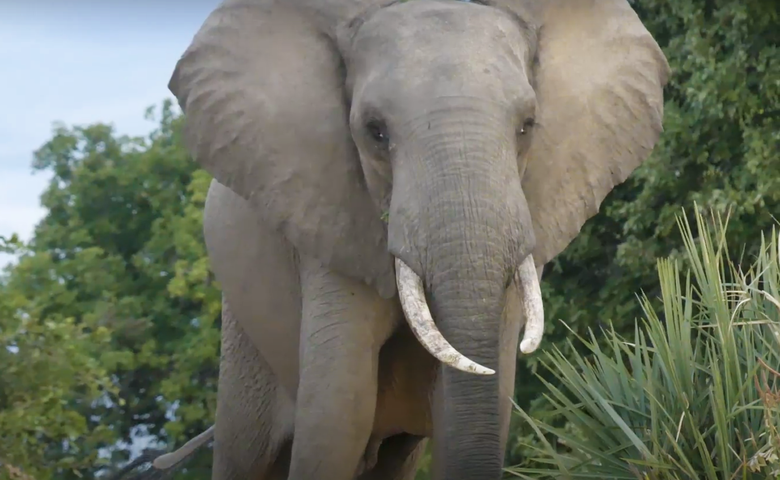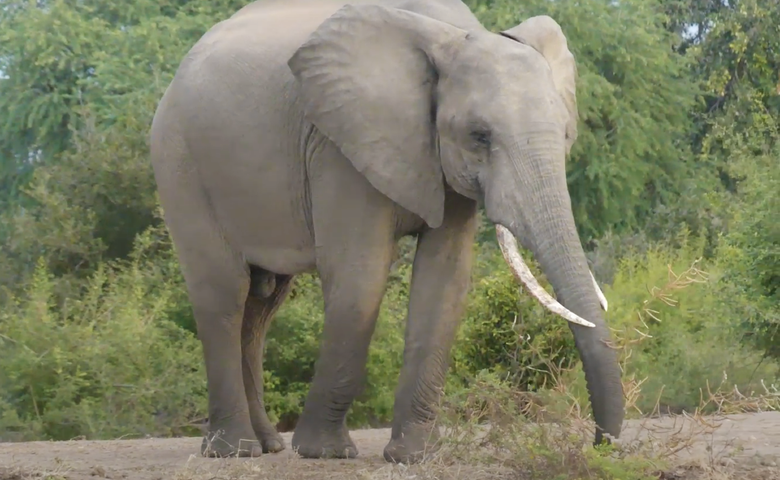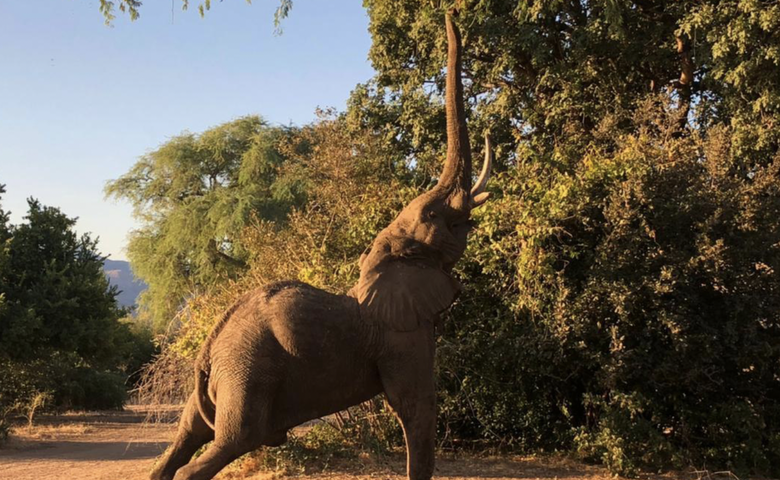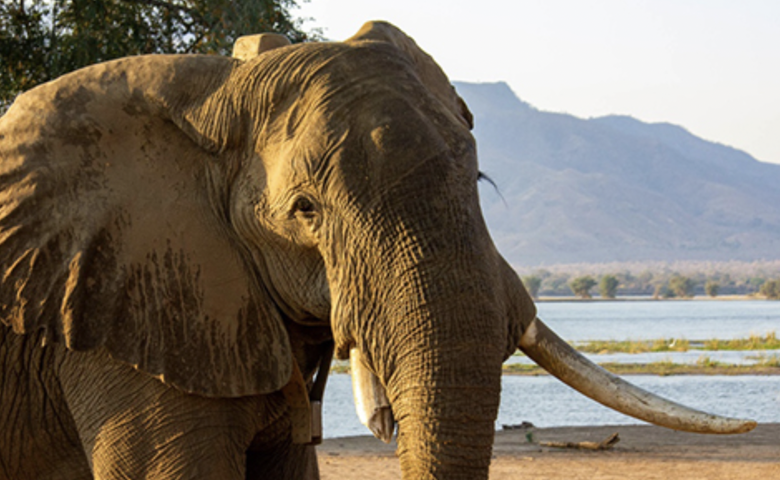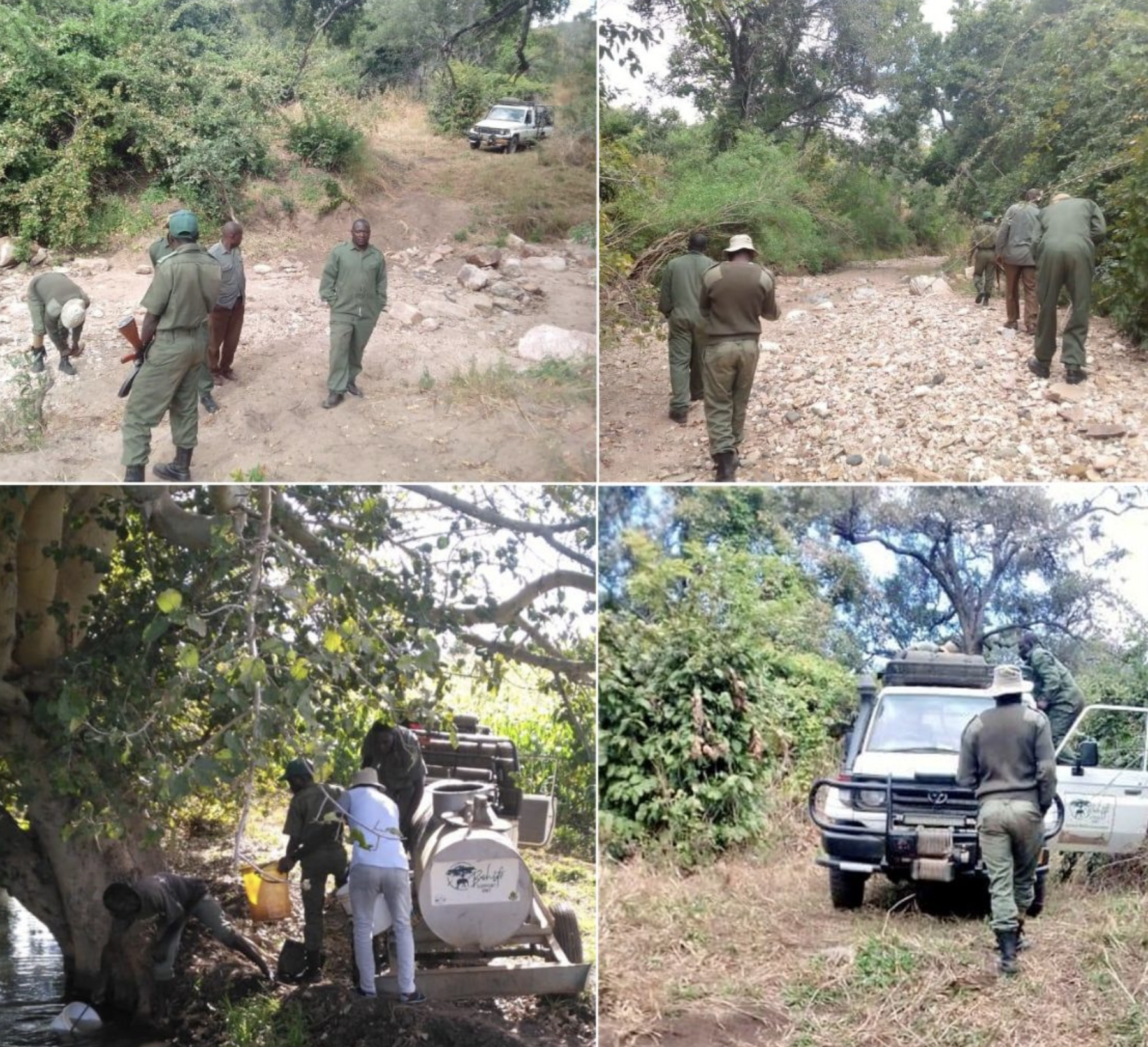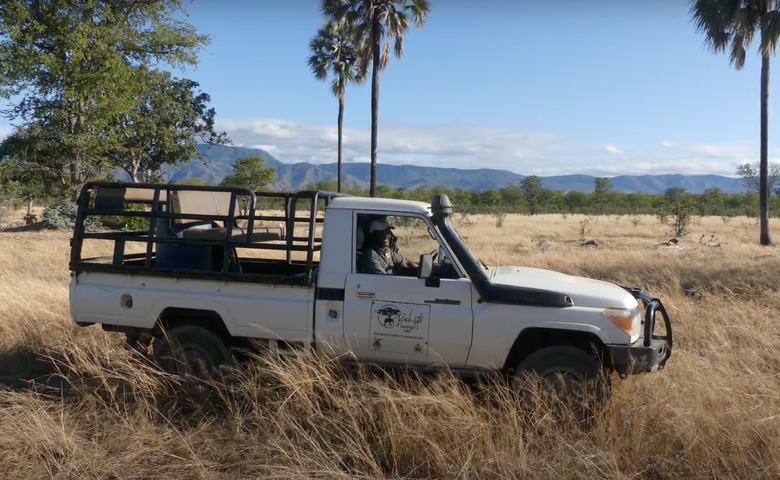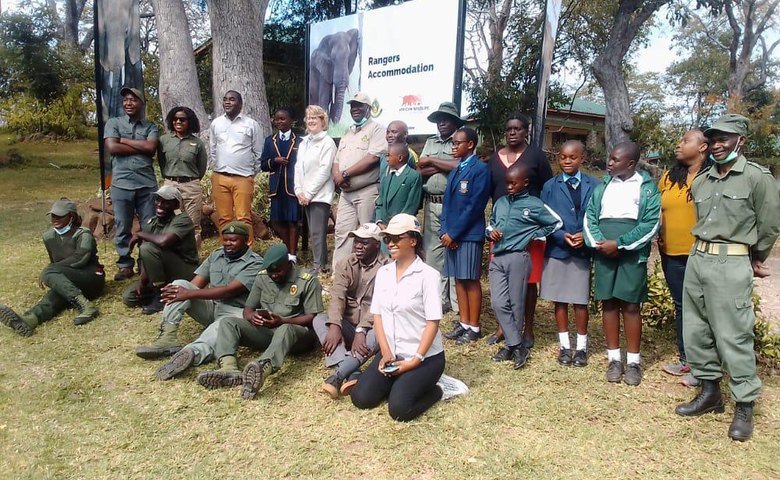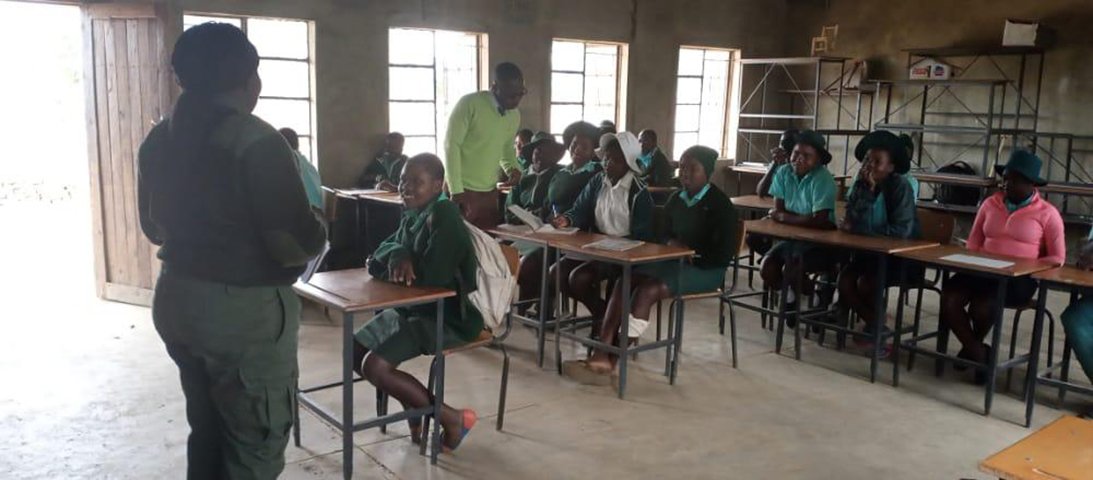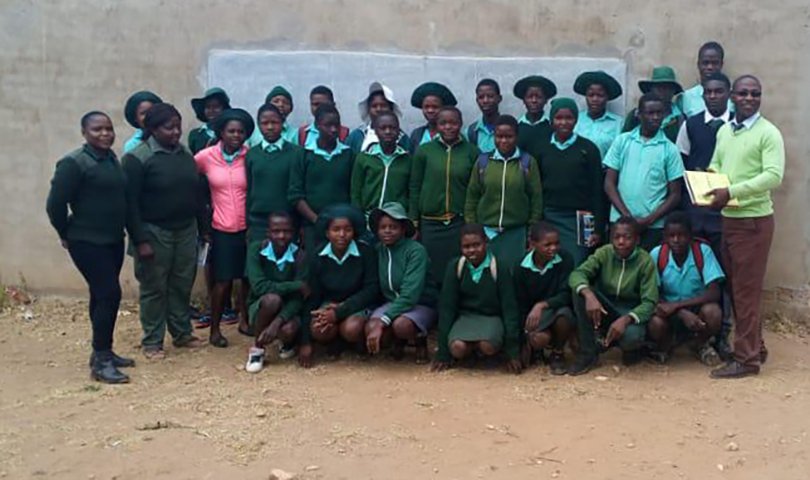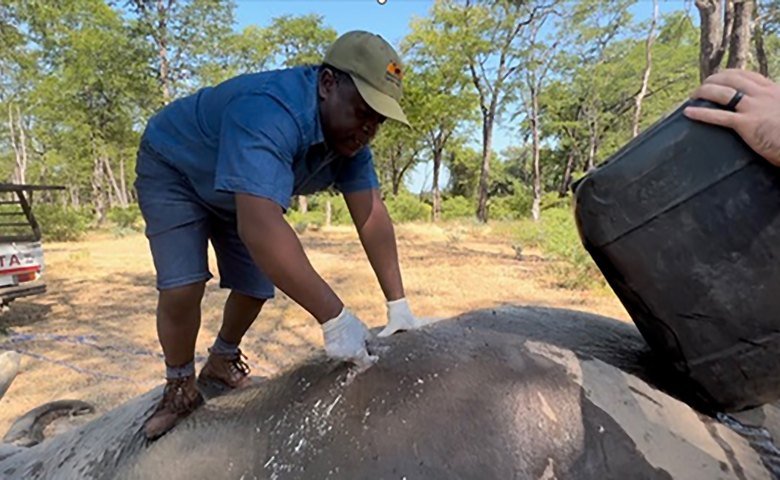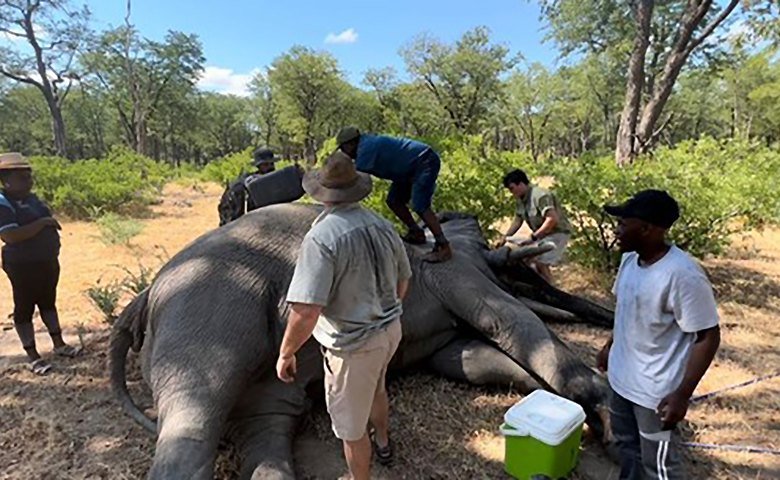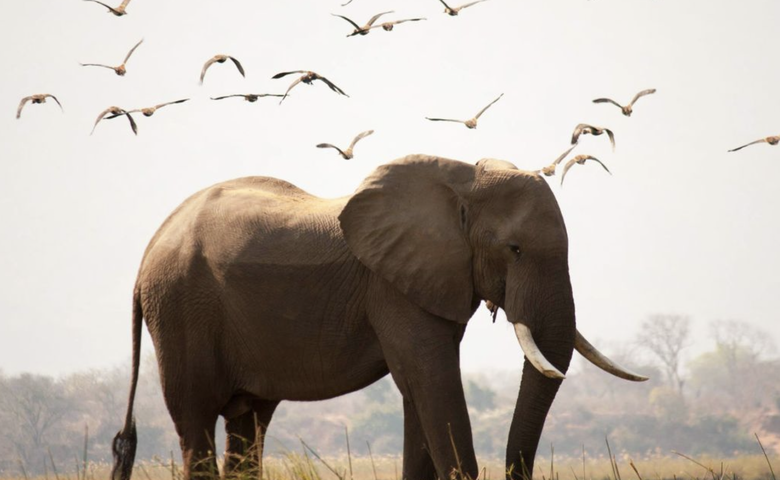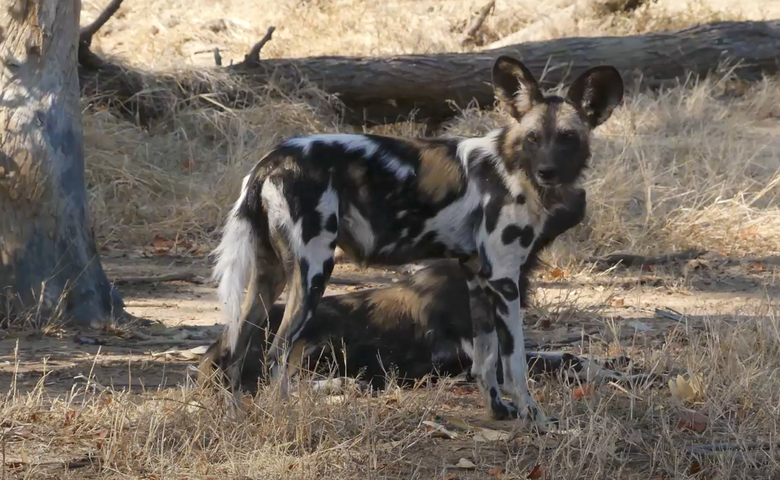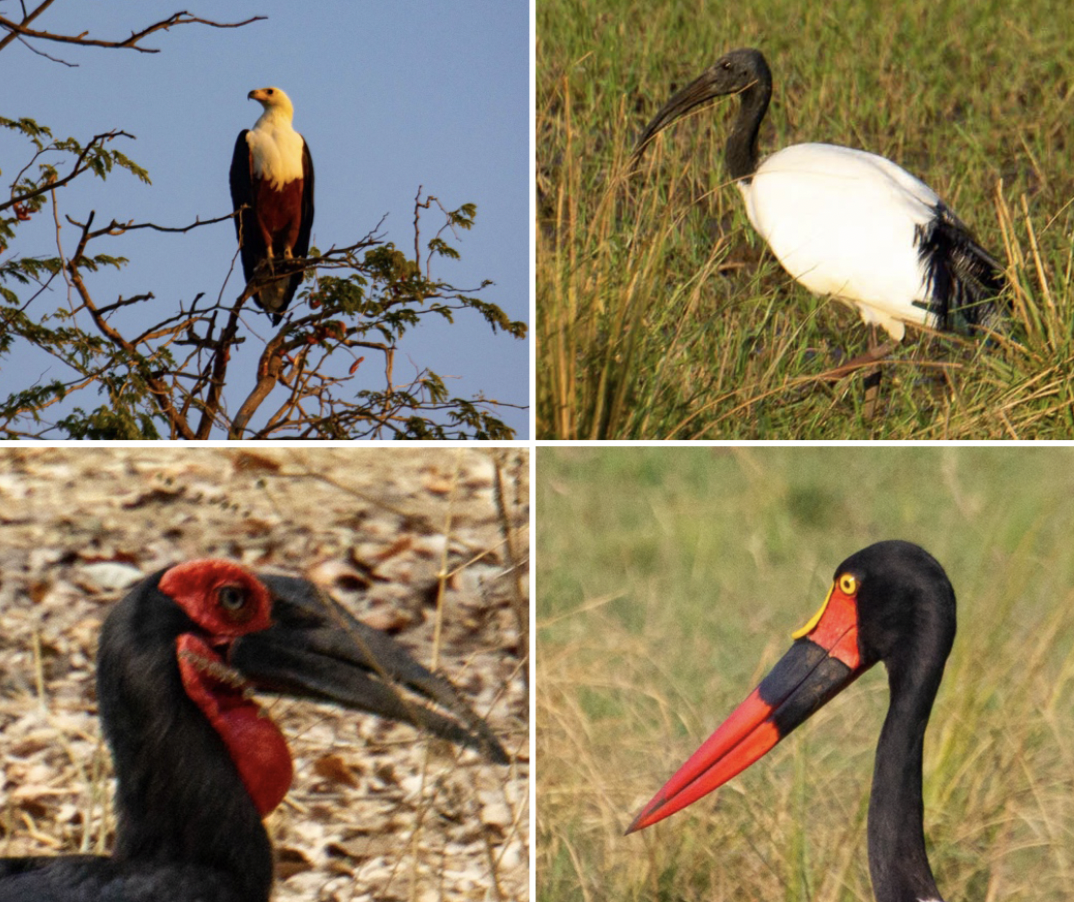Mana Pools National Park Protection - 2022-2023 Progress
FOUR YEARS OF NO ELEPHANT POACHING
The incredible efforts of the Bushlife Support Unit (BSU) keep paying off. Global Conservation is committed to funding BSU, who are happy to announce that there has been no elephant poaching in Mana Pools NP since 2019. BSU is able to provide equipment and logistical support for ranger patrols and coordinate efforts to identify, detain, and arrest poachers and other illegal intruders throughout the valley.
Although there haven’t been any elephants poached in Mana Pools since 2019, several elephants have been poached recently in Hurungwe. In one recent instance, a ranger team responded to gunshots. When they arrived, the elephant’s ivory had been untouched; perhaps it was just the elephant’s meat that the poachers were after, or perhaps the team got there in time to make them run before they could hack off the elephant's tusks. What is considered most valuable continues to shift, from ivory to meat and now vulture parts. In a recent development during the last 6–8 months, poachers have killed 300–400 vultures by poisoning an elephant and leaving its carcass for them to eat. Vultures are key species that keep the ecosystem balanced. Losing such large numbers is a serious concern.
Currently, Bushlife Conservancy is working to protect the area that lies south of Mana Pools in the biosphere reserve. They built a ranger station that can accommodate 14 rangers who are now available to stop the logging, illegal gold panning, and hunting that was going on. The rangers can also prevent settlers from invading wildlife areas. And the results are there; the wildlife population is already rebuilding in the area, as evidenced by sightings of a herd of sable, roan, and buffalo; a pack of wild dogs; and sightings of other carnivores.
In an important development, this week the Zimbabwe and Zambia governments signed an agreement working towards a trans-frontier conservation area in the Zambezi Valley. This means there will be much more cooperation in regards to tracking poachers who try to escape by crossing the border.
Mana Pools National Park is both a wildlife conservation area and a national park that encompasses 220,000 hectares at the heart of the Mana Pools, Sapi, and Chewore Safari Areas World Heritage Site, inscribed in 1984.
Mana Pools is located on the Lower Zambezi River where the floodplain turns into a broad expanse of lakes after each rainy season. As the lakes gradually dry up, the region attracts many large animals in search of water, making it one of Africa's most renowned game-viewing regions.
Mana means ‘four’ in Shona, in reference to the four large, permanent pools formed by the meanderings of the middle Zambezi. These 2,500 square kilometers of river frontage, islands, sandbanks, and pools, flanked by forests of mahogany, wild figs, ebonies, and baobabs, form one of the least-developed national parks in Southern Africa.
Species Facing Extinction
In Mana Pools National Park, we are working with our partners to protect the African savannah elephant, especially super tuskers.
Global Conservation is funding a multi-year Species Population Baseline study for African savannah elephants to ascertain progress in Park and Wildlife Protection from our investments in Global Park Defense in Mana Pools National Park.
A lioness falls victim to a snare set by poachers.
BUSHLIFE SUPPORT UNIT
Global Conservation directly supports BSU in all of its activities.
The Bushlife Support Unit is run by conservationists Nick and Desiree Murray. The organization’s operations cover the Lower Zambezi Valley, an area of 10,000 square kilometers. BSU works in close coordination with Zimbabwe Parks and Wildlife personnel to help patrol remote areas, identify, detain, and arrest poachers, monitor prosecutions and sentencing, and recover and rehabilitate stolen wildlife.
The joint operations between Bushlife Support Unit scouts and Zimparks rangers have been a success in Chitangazuva, Mana Pools' southern boundary base. The team has reported sightings of 5 elephants (a small breeding herd), kudus, zebra, baboons, and hyenas. The southern boundary of Mana Pools has been used as an entry point by poachers in the past.
Global Conservation’s support funds ranger patrol rations, fuel, and vehicle maintenance, enabling Bushlife to deploy rangers on anti-poaching activities in the Mana Pools, Sapi, Nykasanga, Rifa, and Marongora areas. Global Conservation has also provided a Thuraya Satellite Network and Galaxy S8 smartphones to improve communications among ranger teams and for data collection while on patrol.
GSU Supports the Purchase of Three Trucks
Since December, BSU has purchased three secondhand Toyota Land Cruisers to add to the anti-poaching fleet. They are fully kitted out with benches. They also procured an inexpensive pickup truck to replace the anti-poaching vehicle that was temporarily being used for our Community Liaison Officer, Sophia, and have returned the anti-poaching vehicle to the field. BSU is now in a much stronger position to consistently fulfill our mission of protecting and saving wildlife for future generations.
Vehicles will be based at the Kanga base, Mana East base, ZAVARU (Zambezi Valley Reaction Unit), Marongora, and Chitangazuva on the southern boundary. An extra vehicle will be used for rotating from bases as drivers take days off. Freedom will use his vehicle to perform a variety of tasks, and Sophia will use hers to conduct community engagement. This totals 9 vehicles on duty, and there are a couple now on standby for breakdown substitutes.
Education for the Next Generation
Community Liaison Officer Sophia Maseba, herself a professional educator, has been very busy in the last several months working tirelessly with local teachers. Lessons given by BSU's Conservation Education Officer cover a variety of environmental topics. The first term was focused on wildlife seasonal migration, human-wildlife conflict management, and vegetation studies (botany). These conservation activities are a great start in teaching the children how to make a difference. Global Conservation is making BSU and Zimparks conservation and education efforts become a reality.
A Tusker and an Elephant Calf Recieve Medical Treatment
Recently while at Vundu Camp, BSU President Mick Murray spotted a Tusker with a serious wound on his side that needed treatment. I contacted the head veterinarian with the National Parks who spent a week in camp treating Tusker and working on other wildlife.
They darted the Tusker, cleaned his wound, and injected him with a high dose of antibiotics. The wound did not appear to puncture his intestines, which is what appeared to have happened when viewed from a distance. The wound was causing him a great deal of discomfort and probably was from fighting. Tusker appears to be in good condition otherwise and seems to be recovering quickly.
Not long after, BSU darted an elephant calf that was limping on three legs due to a swollen joint on its front left leg. Over the past few years, the BSU team has seen a number of calves with these symptoms. It is critical that BSU determines what is causing this deadly condition in the park's baby elephants. They walk on 3 legs and die from the challenges of carrying their own weight. The oldest calf they have seen with this condition is about 4 years old. We drew blood from the darted calf and tried to take a fluid sample of the swollen joint, but it was not soft tissue. It was hard as if it were calcified. This was the start of a project, and the next step will be to X-ray the joint. BSU's goal is to X-ray 10–15 of the afflicted calves. There is only one mobile X-ray machine in the country, and BSU is working to determine the cost and logistics.
Poacher Camp Destroyed
The BSU anti-poaching team based at Chitangazuva also reports that in early July 2022, two BSU scouts and a Zimparks ranger conducted a patrol toward Chewore (part of the UNESCO site, east of the Mana Pools southern boundary). They spotted human footprints and followed them, locating a bush camp and evidence of gold panners and poachers. Unfortunately, the individuals escaped, however, the team destroyed the tools and equipment they found at the site. We are very pleased with the efforts of BSU's scouts and Zimpark rangers. The previous photos were taken by BSU Driver Charles.
INTERNATIONAL ANTI-POACHING FOUNDATION
GC Funds Expansion of "The Brave Ones" Into Mana Pools
Further adding to expanding effective patrol measures, the Global Conservation grant was awarded to the International Anti-Poaching Foundation (IAPF), in support of the growth and effectiveness of IAPF’s world-famous Akashinga Program and Wildlife Crime Unit, which was introduced in Zimbabwe in 2017 and has grown substantially in the past five years.
Image by Kim Butts
The all-women anti-poaching unit, led by Damien Mander, Founder of the Akashinga Conservation Army, started with 16 women. The Akashinga program has grown to 500+ staff with a wilderness protection portfolio totaling over 9 million acres across four countries (Zimbabwe, Botswana, Mozambique, and Tanzania). The goal is to employ 1,000 women by 2026 and protect 30 million acres of wilderness by the end of the decade. A substantial contribution towards safeguarding Earth’s self-regulating system of nature.
Akashinga landscape management footprint and expansion underway:
Zimbabwe: The Zambezi Valley (Active) - 1,300,000 acres
Mozambique: Sofala Province, Savé Region (Active) - 2,200,200 acres
Botswana: Kalahari Transfrontier Area (Active) - 5, 000,000 acres
Tanzania: South Western Conservation Complex (Active and finalizing additional landscape) - 625,000 acres
Global Conservation recently concluded a $20,000 USD grant that helped support the expansion of Akashinga in northern Zimbabwe, focusing on expenditures related to the primary goals of the Akashinga program, including wildlife law enforcement, community conservation, female empowerment, and community development. The goals are reached by the training and deployment of all-women ranger teams to protect wildlife in the Zambezi Valley, Zimbabwe, providing multiple benefits such as:
Improving and initiating wildlife protection in wilderness areas formerly used by trophy hunting outfitters. These areas are surrounded by wildlife preserves and/or National Parks and have had marginal wildlife or lapsed protections.
Strengthening the use of intelligence, investigations, and prosecutions - supporting the overall capacity to gather intelligence and convert it into effective prosecutions that result in convictions and sentencing. Intelligence gathering remains essential in our operations and key to our success. This supports informer management, incentives, and information regarding illegal wildlife activities.
Providing rangers with upgraded state-of-the-art technology to collect reliable data and track their patrols. Effort-based performance metrics are essential for monitoring and enhancing the effectiveness of anti-poaching rangers in the long term.
Creating a wildlife protection regimen that:
Improves wildlife protection and supports local communities that are surrounded by these wild lands. The support provides for both the conservation benefits of the ranger training and deployment as well as the community benefits that accrue to the local communities generated by the infusion of salaries earned by the rangers and spent within those communities. This is far greater than the income provided by trophy hunting.
Generates significant opportunities for at-risk women in these communities by placing wildlife protection in the hands of highly trained women, carefully recruited and trained after demonstrating their commitment to the wildlife and community goals defined by Akashinga.
Investing in the future generation through access to education and conservation-specific curriculum in classrooms.
Advancing a model that melds wildlife protection, women’s empowerment, and community support, thereby creating an ideal wildlife management system for Africa’s wilderness areas.
Global Conservation is grateful to the IAPF for their incredible work and GC is honored to aid the growth and expansion of Akashinga and IAPF’s Wildlife Crime Unit (WCU). We look forward to a continued relationship to dramatically enhance the protection of critical wildlife habitat and active corridors protected by Akashinga in 2023 and beyond.
IAPF’s Impact by the Numbers
IAPF continues to demonstrate the critical importance of integration between the protection of imperiled flora and fauna and the integration and support of communities within and around crucial habitats. Through the strategic integration of IAPF’s Akashinga and Wildlife Crime Unit (WCU), we have achieved significant success in our traditional and new geographies. Nature protection activities include patrolling vast areas, penetrating poaching syndicates, arresting poachers, confiscating contraband and illegal weapons, rescuing live animals (particularly pangolin), and holding conservation community meetings related to the importance of abundant wildlife to the long-term prosperity of communities in Zimbabwe.
To date, IAPF’s Akashinga and WCU, working alongside local agencies, have made a total of 1369 arrests in 724 separate operations, for a total of 705 wildlife offenses, including 106 pangolins, 65 weapons (multiple calibers recovered), 16 rhino horns, 61 animal skins, and more than 500 snares removed. Patrols and arrests have continued to gain momentum, with an overall conviction rate of 85.2% between 2017 and 2022 (excluding ongoing cases).
Tusks are confiscated by the Akashinga Conservation Army.
In 2022, our Akashinga rangers and WCU teams made a total of 275 arrests in 198 separate operations for a total of 161 wildlife offenses, including:
118 elephant tusks recovered, two of which were fake
24 pangolins recovered alive
25 weapons recovered (including: a.303, 12-gauge shotgun and an AK47)
1 rhino horn recovered
Multiple snares removed
8 animal skins were recovered (lion, leopard, bushbuck, duiker, and civet)
4 Illegal logging Ops (3 axes and several logs recovered)
15 Illegal boats impounded
37.6km of illegal Monofilament Fishing nets were destroyed
5 Illegal Mining Ops
3 bushmeat Ops (parts of three animal species recovered: duiker, warthog, and elephant)
1537kg of fish recovered
Multiple Wildlife-Human Conflict (HWC) cases mitigated
The overall conviction rate is 84.4%.
Further, IAPF’s Wildlife Crime Unit has been at the forefront of dealing with wildlife crime in the Hwange, Chete, Chizarira, Chirisa, Matusadona, and the Mana Pools area (this includes the entire Southern Boundary of Mana Pools and Parks to the SE and SW of the land IAPF lease and protect). Mana Pools National Park and Zimbabwe’s Zambezi Valley continue to be at extremely high risk for wildlife poaching and habitat encroachment activities. Mana Pools, a UNESCO World Heritage Park since 1984, is home to large herds of elephants, lions, cheetahs, wild dogs, and near-threatened species including leopard and the brown hyena. A case study showed that in 2018, despite IAPF’s pilot area Phundundu representing an area of 13.6% the size of Mana Pools to the north, Phundundu had an arrest rate of 4,450% higher than Mana (87 arrests v 2). This played a significant role in helping to halt an 80% downturn in elephant poaching across the region as reported by the National Parks Department figures.
CG Supports The African Wildlife Foundation With A $125,000 Donation
Our contribution to African Wildlife Foundation supports law enforcement and anti-poaching activities in the area surrounding Mana Pools National Park and the Lower Zambezi Valley. AWF works to maintain and increase elephant populations. AWF’s efforts in this landscape are crucial to supporting Zimbabwe’s broader conservation efforts including bringing rhinos back to the landscape in the long term. Conservation Global will also continue to donate $20-50,000 a year to ensure healthier ecosystems and the fight against poaching.
THE CROCODILES:
ZAMBEZI RIVER SPECIALIZED ANTI-POACHING UNIT
GC Donations of $50–100,000 per Year to the African Wildlife Foundation Enable Massive Changes
The Mid Zambezi Cluster is one of Zimbabwe’s wildlife landscapes, endowed with unparalleled biodiversity and awe-inspiring landforms. Besides the protected terrestrial wildlife landscape comprising of Charara Safari area, Hurungwe Safari area, Mana Pools National Park, Sapi Safari area, Chewore North Safari area, Chewore South Safari area, Dande Safari area, Doma Safari area, and Chinhoyi Caves Recreational Park, the Cluster also manages an aquatic ecosystem made up of Lake Kariba and the Mid Zambezi river stretching from below the Kariba dam wall all the way to the Kanyemba border in Mbire District. It is this Zambezi River stretch that the Zambezi River Specialized Anti-Poaching Unit (AKA ZARSAU or the Crocodiles) was established to monitor and protect. The Crocodiles area of jurisdiction covers a 255 km river stretch from the Kariba dam wall to Luangwa/Zambezi confluence, as shown on the map below.
The principal objective of the Crocodiles is to carry out regular river patrols along the Zambezi River from the Kariba Dam wall to the Luangwa/Zambezi confluence in order to ensure maximum protection of all protected areas that run along the Zambezi River on the Zimbabwean and Zambian sides. They achieve this objective by conducting a number of different types of patrols including:
Extended river patrols
Daily river patrols
Strategic river patrols
River reactional patrols
River surveillance patrols
PATROL STRATEGIES
Below is a short explanation of the strategies used by the ZARSAU Crocodiles in 2021 and 2022:
Two river patrols were carried out daily to complement two ten-day extended patrols per month, one upstream from the rear base and another downstream from the rear base.
Incursions and poaching reports were treated as such and a standby team was always ready to react within the first 30 minutes of receiving a report.
Joint river patrols with Zambian law enforcement agencies were carried out covering all known exit and entry points across the Zambezi River.
Two more informers were recruited to intensify the gathering and sharing of intelligence across borders.
A full moon ranger deployment strategic plan was developed and implemented to ensure all poacher entry and exit points are manned during full moon periods.
Twelve camera traps were deployed randomly to monitor known entry and exit routes throughout the period.
Monitoring radar was being deployed once every week to compliment teams on river patrols.
At least one patrol team was on the river patrol every day and night.
Regular training was conducted to sharpen team skills and develop confidence.
Highlighted Achievements by the Numbers:
Poaching Incursions drop by 40% each year since support started from Global Conservation
26 Arrests with 21 Convictions
34 Boats Confiscated
56,740 Fishing Nets Confiscated
As a detection strategy to find poachers, camera traps were deployed in these areas, as shown on the map below, to complement efforts by patrol teams on the waters. Three camera traps were deployed inland in Mana Pools and Chewore, targeting known poachers' routes.
Most poaching incidences recorded in Mana Pools and the entire Zambezi Valley showed that poachers used entry and exit points between the Nyakasanga River and the Kariba Dam wall. When ZARSAU was established, one of the principal tasks was to ensure that the known poachers’ routes were always patrolled and monitored to prevent illegal entry or to quickly detect any illegal entry.
Thanks to the support of Global Conservation, the number of river patrols increased from 25 in 2020 to 330 in 2021. Boat patrol operation hours increased from 80 in 2020 to 577 in 2021. And the availability of rations made it possible for rangers to spend many hours in the field, hence the increase in patrol coverage.
In addition, in 2021, the unit was able to realize an increased number of arrests as compared to 2020, an increased number of illegal fishing nets confiscated, and an increased number of illegal fishing boats impounded.
After the equipment was received by The Crocodiles, they spent time ensuring that users were trained on the gadgets prior to deployment. Camera traps were also delayed, causing their deployment to start in 2022. All twelve cameras were deployed on an average of thirty days covering the most known poacher’s entry and exit routes. A total of 360 days were spent with the cameras in the field.
Overall, the unit has done a tremendous job, as shown by declining incidences of poaching and incursions.
"Achievements over the past year would not have been possible without your support. AWF is incredibly grateful for your continued generosity in helping to provide the tools and resources needed to continue progress in the Lower Zambezi Valley."
- Zambezi River Specializes Anti-Poaching Unit











